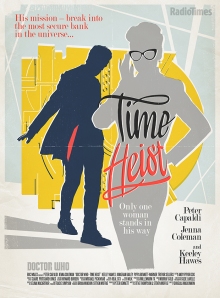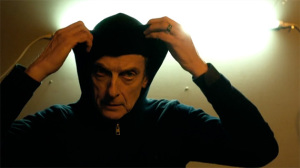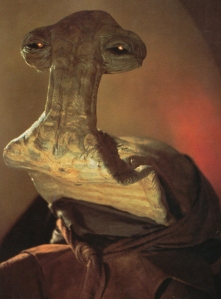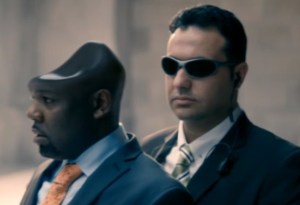Airdate: September 20, 2014
Written by: Steve Thompson & Steven Moffat
Directed by: Douglas MacKinnon
The Story So Far: As the Doctor tries to convince Clara to cancel her date with Danny and go exploring with him instead, the TARDIS phone rings, and the two are magically whisked away to the Bank of Karabraxos… where they are forced by The Architect to rob the bank. Fabulous riches may await if they succeed, but their brains will be turned to soup by The Teller if they fail…
I’ve just had a hard time wrapping my head around Time Heist. Many reviews I’ve read were faintly disappointed in it. Head Over Feels found it to be fantastically entertaining, on the other hand. I appreciated a lot of the individual lines and some of the emotional beats but… at least for the moment, it just hasn’t amounted to a coherent whole for me yet. As usual, most of my first impressions have to do with what other past Doctor Who episodes most closely resemble the individual elements in Time Heist. Like, all that stuff about the TARDIS spinning its way through space? Totally lifted from the Tom Baker era!
1. Old home week
Par for the course for me in Season 8 so far, I didn’t get to watch Time Heist at home. I watched it in a hotel in Atlanta, after a long day of touring the city. I was there with Stephen, whom I’ve known since 1979 — in fact, he introduced me to Doctor Who 30 years ago, when we were 11 (so obviously he has a lot to answer for since then). I was hoping for an interesting live-blog experience from Stephen, but, apart from some interest in Jenna Coleman, he didn’t seem all that wowed by the episode. Sorry.
2. Stephen Thompson
Before the episode aired, I heard grumblings online about Stephen Thompson’s past episodes for the show, and what that potentially meant for Time Heist. The man’s C.V. consisted of only two Who stories: the mindless The Curse of the Black Spot, and the frustrating Journey to the Centre of the TARDIS. This time along, he had Steven Moffat credited as co-writer, which most likely means that Moffat substantially rewrote Thompson’s original script, bringing it more in line with the overall arc of Series 8. History will eventually tell us which bits were Thompson’s and which bits were subsequently added by Moffat, but my guess would be that the characters eventually played by Keeley Hawes were substantially retro-fitted by the Moff.
Time Heist wound up being, for my money, the best of Thompson’s three episodes. If he can keep this up, I’d put his output about on par with the Classic Series episodes written by Bob Baker & Dave Martin. Good enough to keep coming back for a story a year, but never quite rising to the transcendent heights of a Robert Holmes or a Paul Cornell.
3. Ashes to Ashes
Featuring prominently in the teaser for Time Heist was another one of those librarian/dominatrix types that we’ve seen quite a bit in past Moffat episodes: Missy, Madame Kovarian, Tasha Lem. I read at least a few pieces of speculation that this was going to be the week we finally got Missy’s backstory. Which I… continued to believe for a not insubstantial portion of the duration of Time Heist. Until I realized that that wasn’t Missy at all.
Keeley Hawes continues the welcome trend of previous cast members from Life on Mars/Ashes to Ashes popping up on Doctor Who. What’s interesting for me is that Time Heist aired just a few days before the 10th anniversary of Lost, a series that started strong and continued to captivate most of us for its six seasons on the air… until the final episode, which cast aside almost all of that good will. What particularly stung about the Lost finale was that it aired the same week as the Ashes to Ashes finale… and Ashes to Ashes managed to strike correctly, every note of the same themes that Lost bungled so magnificently.
All of which is a fancy way of saying… she didn’t turned out to be Missy after all, but Keeley Hawes was definitely one of the highlights of Time Heist.
But we’re still left with the dangling question… who did give Clara the phone number to the TARDIS? Karabraxos had it, triggering the events of this episode, but she’s clearly not the same person who called Clara. So we haven’t yet settled that little bit of solution.
4. Pseudo-companions
Something the Classic Series used to be good about was introducing one-off characters who could have been companions, and in some cases wound up being better than the companions who were ultimately selected. Examples include Samantha Briggs in The Faceless Ones (when Pauline Collins declining to become a regular), Chris and Clare in Shada, Ray in Delta and the Bannermen (Sara Griffiths likely would have been the new companion instead of Ace, had a few things broken differently in the production office) and just about the entire guest cast of The Awakening.
The New Series typically hasn’t had much need for the pseudo-companion (unless you count someone like Adam in Dalek and The Long Game); the actual companions are worked into the individual season narratives, and come with their own orbit of recurring characters (Jackie Tyler, the Jones family, Wilf, Danny Pink). But with Psi and Saibra in Time Heist, there’s the overt sense that these are characters who could have been made regulars. Each one has their own journey to explore, their own flaws (Psi’s memory, Saibra’s rogue shape-shifting); each one is recruited by the Architect for a specific reason; each one has a lingering farewell in the TARDIS at the end of the story. Time will tell if these characters are destined for repeat appearances.
5. The Architect
One of Stephen’s first pertinent observations about the episode (not counting long looks at Clara) involved the voice of the Architect. “Isn’t that the guy from Saw?” The disembodied, digitally-altered voice in the American accent did remind me a little bit of Tobin Bell. This was delivered in an impressive first scene, immediately after the opening credits, in which the Architect reveals that the Doctor and company are unauthorized intruders in the Bank of Karabraxos — at which point, an angry security guard bangs on the door and shouts “Open up, or you shall be humanely disposed of!” (definitely not American security then).
The end reveal is that the Architect is actually the Doctor. Which, on the one hand, means that the plot essentially resolves itself out of existence: the Doctor set up the whole scheme in advance, so that there were no means of failure, and that the seemingly tragic, dark deaths of Psi and Saibra in the middle going were absolute red herrings.
The Doctor setting himself up as a dark manipulating force has been done before, and often in very highly regarded stories. The 2nd Doctor in The Evil of the Daleks is forced to manipulate Jamie into undergoing a series of dastardly tests; we’re there as the Doctor is given this mission, and we share in his discomfort when Jamie angrily confronts him over what’s been going on. We’re witness to the 4th Doctor emotionally manipulating Sarah Jane in The Ark in Space as she’s busy freaking out on a very important mission, but the camera stays on Tom Baker’s face so we can see that he’s not actually trying to hurt her. And, most famously, the 7th Doctor, in nearly every story in between Remembrance of the Daleks and The Curse of Fenric, would land somewhere already fully aware of what was going on, and already halfway through his scheme of taking down that episode’s Big Bad… while giving Ace exactly no advance information, and often leaving her to fend for herself in alien environments, assuming that she’d pull through in the end.
The 12th Doctor setting himself up as The Architect does not quite reach the manipulative levels of the 7th Doctor era. The end revelation about the Architect (“So he was the Doctor all the time!”) removes the sting retroactively — but it’s certainly a very chilling pair of moments (and quite similar to one we already saw in Into the Dalek) when we think that the Doctor is handing suicide devices to both Saibra and Psi, in order to spare them an even more painful death at the hands of…
6. The Garm
1983’s Terminus is an utter mish-mash of a story, attempting to do 12 different things at once, and succeeding at very few of them. Floating somewhere around the margins of the second half of that story is something called the Garm, a tall, bipedal, lupine creature that’s been enslaved in the service of administering a cure for Space Leprosy. That serial’s author, Stephen Gallagher (again with the Stephens this week; this post is now up to four of ’em) evidently intended for the Garm to be a shadowy, menacing creature, never fully revealed on camera.
But, Terminus was produced in 1983, when the BBC’s lighting technicians would literally calibrate their lamps by making sure that a pencil placed on the studio floor cast no shadow in any direction; its director, Mary Ridge, had never worked on Doctor Who before, and never would again. So, the Garm ended up looking like this.
By the end of Part Four, Terminus‘ final installment, we learn that the Garm, as muscular as it’s shown to be on screen, and as menacing as Stephen Gallagher probably intended it to look before handing off his scripts (with satisfaction, no doubt) to Eric Saward and John Nathan-Turner… was actually just a good little doggie, who was tired of being enslaved, and wanted to be free. The 5th Doctor grants him that wish… and then promptly tells his former overseers that they should lure him back to work anyway.
7. The Teller
Which brings us to the slavering alien menace at the center of Time Heist. The Teller is the in-house security system on the Bank of Karabraxos. It will scan your brain waves, and turn your brain to soup if it finds evidence of fraud or deceit (this would have been a very handy thing to have in the United States prior to the subprime mortgage-backed securities crisis that triggered the worldwide financial meltdown a few years ago). The Teller is kind of a bipedal rhinoceros, with eyes on two different stalks. Like the Garm, it too is not kept to the shadows. Unlike the Garm, it will probably look much more convincing to its audience 30 years from now than the Garm looks to us today. Here’s a picture of the Teller.
Um, oh, wait. Sorry about that. That’s Hammerhead from Star Wars: A New Hope. I played with Hammerhead’s action figure incessantly from the late 1970s until… well, honestly, until I was 16, but let’s just keep that between us. The Teller looks nothing like Hammerhead.
The Teller is the soft, tender heart at the center of Time Heist‘s action/adventure heroics. The real mission that the Architect has for the Doctor is to free the Teller from slavery (at the request of a dying Karabraxos, years later). The Teller was thought to be the last of its kind (where have we heard that before?), but it turns out that Karabraxos enslaved it by keeping its significant other chained up in the closet. The Doctor frees the Teller and its girlfriend, and sends them off to their own planet to live happily ever after. This is all quite similar to how the Garm was used in Terminus… except, with a happier ending.
8. “Stir up the Campbell’s — soup is good food!”
The Teller, as I mentioned earlier, turns your brain to soup if you have evil in your heart (or some other mixed metaphor like that). We find out that the Teller will literally make your brain deflate, and drip out your tear ducts, leaving your head looking like this.
A nice visceral image, something for you to have nightmares about, especially as the poor sap with the melted head has to live like that for most of the rest of the episode. Except, as Stephen, who’s a doctor (not the), pointed out… the Teller would have had to melt the poor sap’s skull, in addition to his brain, in order for that look to be achieved. So I guess the Teller melts bone as well as brain?
9. The Doctor’s A Little Jealous
We’ve seen lots of evidence the past few weeks that the Doctor’s not very good at handling competition where Clara is concerned. That’s revealed quite nicely in the following sparkling exchange, which closes the episode.
The Doctor: 7:12 local time, as promised. Go enjoy yourself. Don’t do anything I wouldn’t do.
Clara: This is a date, yeah? [beat] I’ve just realized, I’m going out for another meal now.
The Doctor: Don’t worry, calories consumed on the TARDIS have no lasting effect.
Clara: What, are you kidding?
The Doctor: Of course I’m kidding. It’s a time machine, not a miracle worker. Bye-bye!
Clara: See ya. Don’t rob any banks.
The Doctor: Don’t rob any banks what?
Clara: Without me.
The Doctor: Close enough, Boss. [Clara leaves] Robbin’ a bank, robbin’ a whole bank. Beat that for a date.
Up til now, we’ve assumed that the relentless teasing of Clara was just a feature of the new Doctor’s personality. But now, and I’m sure we’ll see more of this going forward, it seems that the teasing is meant to cover for the Doctor’s huge burning terror that Clara is going to have fun without him.
10. Next Time
Finally, an episode that none of us on the Interwebs have (had the opportunity to have) seen or read yet: The Caretaker. In which, it appears, Clara’s efforts to juggle both a long-term relationship with Danny Pink, and take irregular jaunts with the Doctor, are wreaking havoc with her life. A situation which the Doctor decides to exploit by getting a job at Coal Hill School, presumably to keep an eye on Clara and Danny. Also, there’s a robot.









As we’ve already established, I’m in agreement with you on this one. I hadn’t thought of the similarities to Terminus though.
I also agree about Delphox/Karabraxos fitting into a very Steven Moffat mold. Many of his female villains seem interchangeable; in this case Delphox/Karabraxos could easily have been connected to Missy.
Pingback: 12 thoughts on “Mummy on the Orient Express” | "Doctor Who" Novels